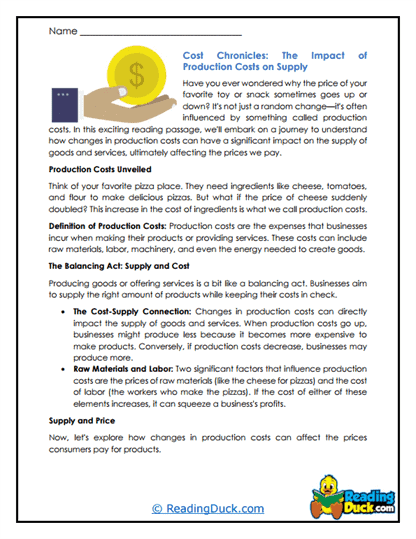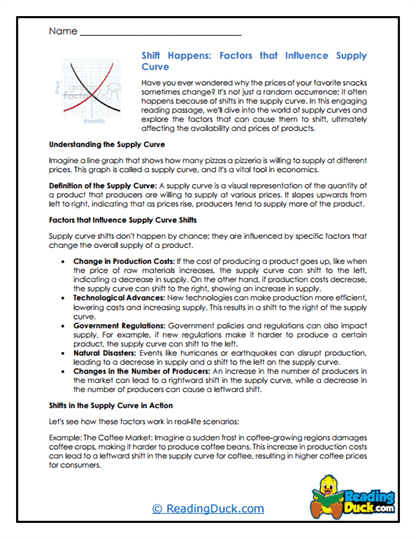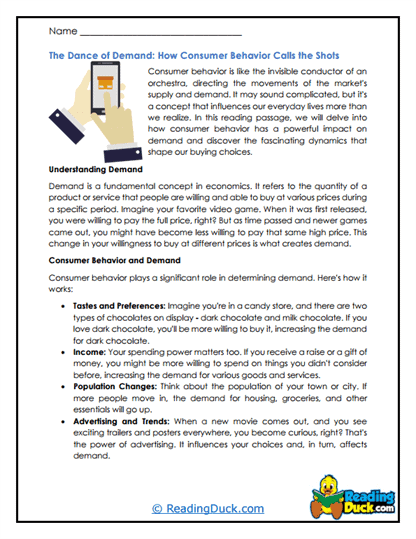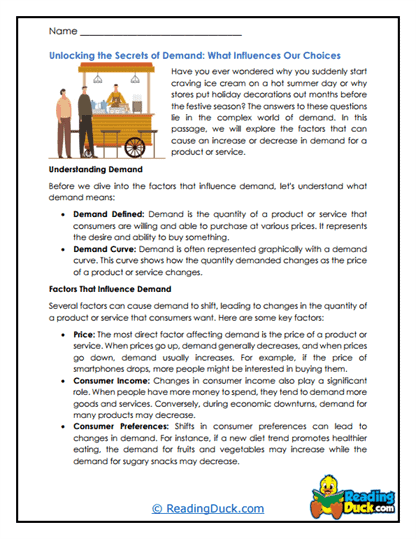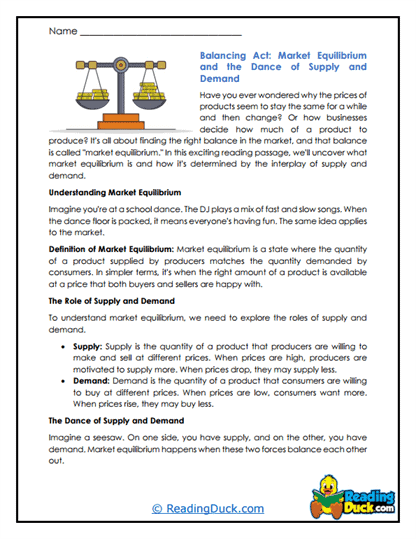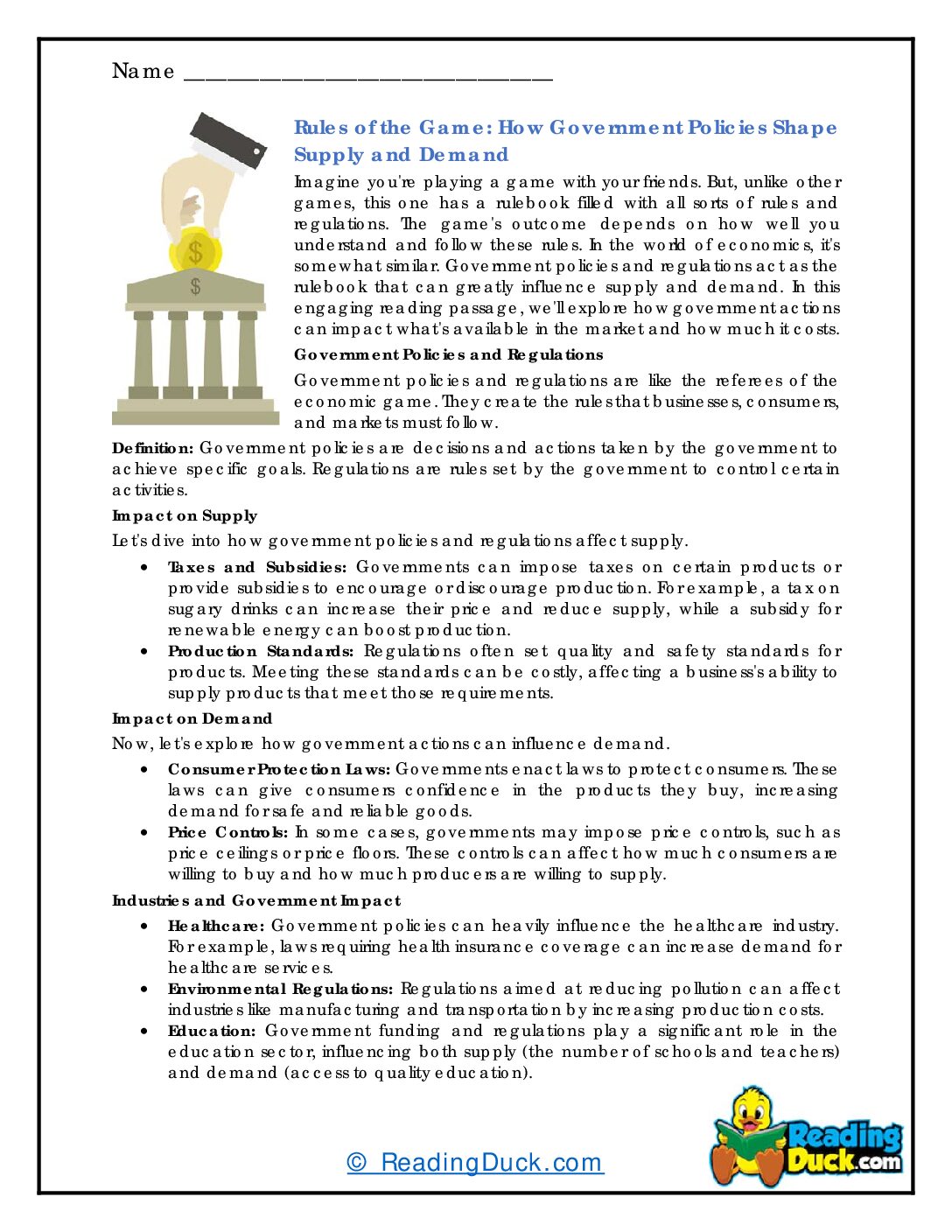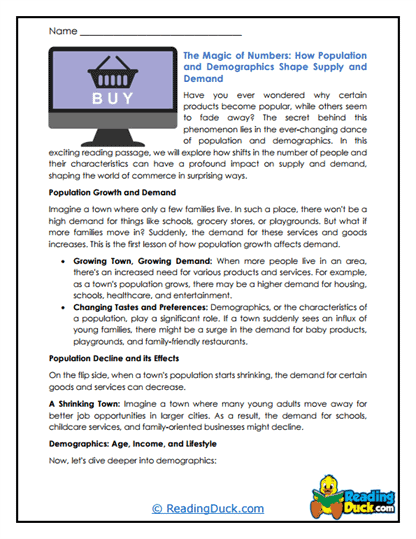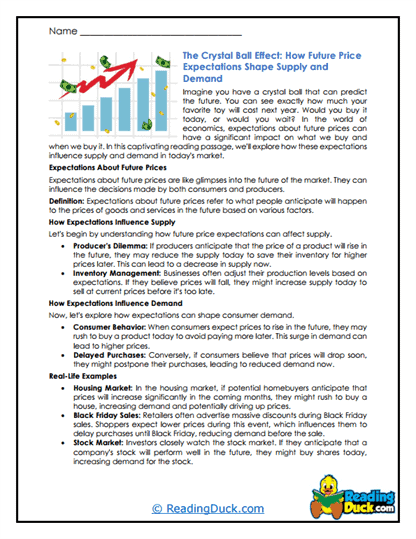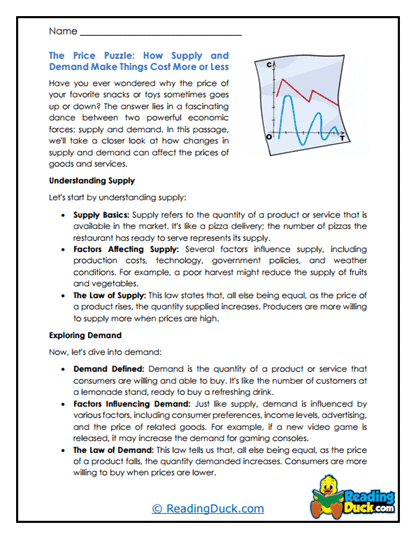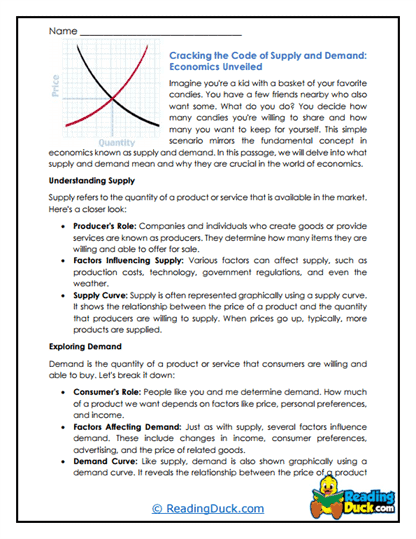Supply and Demand Worksheets
About Our Supply and Demand Worksheets
Our Supply and Demand Worksheets provide students with a comprehensive understanding of one of the fundamental concepts in economics: the relationship between supply, demand, and price. These worksheets are part of the broader Economics category, which covers various topics such as Banking, Budgeting, Companies, Economic Systems, Financial Literacy, and more. This collection specifically focuses on supply and demand, guiding students through the principles that drive markets and influence decision-making in both personal and professional contexts.
This topic contains several worksheet sets, each focusing on a specific aspect of supply and demand. Each worksheet set includes:
- Multiple Choice Questions: These questions assess students' comprehension of the reading passages, focusing on key details about the law of supply and demand, market equilibrium, shifts in supply and demand curves, and the factors that influence these shifts.
- Short Answer Questions: Students provide concise responses, summarizing important information, analyzing real-world scenarios, and reflecting on how supply and demand concepts apply to everyday life and business decisions.
- Open-Ended Questions: These questions encourage students to think critically and express their personal interpretations, opinions, and preferences related to supply and demand topics, allowing them to connect the material to their own experiences and future goals.
These worksheets help students demonstrate their understanding of supply and demand while fostering meaningful engagement with the subject. An answer key is provided for each question sheet, making it easy for teachers and parents to evaluate student progress. All worksheets are available as PDF files, which can be easily viewed electronically, downloaded, and printed.
Understanding Supply and Demand: The Core of Economic Decision-Making
Supply and demand form the cornerstone of economics, dictating how goods and services are allocated in markets. The concepts of supply and demand explain how prices are determined, how resources are distributed, and how markets respond to changes in conditions. By studying supply and demand, students gain valuable insights into how economies function, how businesses make pricing decisions, and how consumers and producers interact in the marketplace.
When studying supply and demand, students encounter a variety of key concepts and areas of interest:
- The Law of Supply and Demand: At the heart of this topic is the law of supply and demand, which states that the price of a good or service is determined by the quantity available (supply) and the desire of buyers to purchase it (demand). Students learn how these forces interact to establish market prices and quantities. For example, when demand for a product increases and supply remains constant, prices tend to rise. Conversely, when supply increases and demand remains steady, prices typically fall. Understanding this basic principle helps students grasp the dynamics of market behavior.
- Market Equilibrium: Market equilibrium occurs when the quantity of a good supplied equals the quantity demanded at a specific price. Students explore how markets naturally move toward equilibrium, where supply meets demand, and how shifts in supply or demand can disrupt this balance. They learn to analyze equilibrium graphs, interpret supply and demand curves, and understand the effects of surpluses and shortages in the market. This knowledge equips students with the tools to evaluate market conditions and predict how changes in supply or demand might impact prices and availability.
- Shifts in Supply and Demand: Supply and demand are not static; they can shift due to various factors such as changes in consumer preferences, technological advancements, production costs, and government policies. Students examine the causes of shifts in supply and demand curves and their effects on market equilibrium. For example, a technological breakthrough might lower production costs, shifting the supply curve to the right and reducing prices. Understanding these shifts helps students analyze real-world economic events and their impact on markets.
- Price Elasticity: Price elasticity measures how responsive the quantity demanded or supplied is to changes in price. Students learn about the concepts of price elasticity of demand and supply, exploring how some goods are more sensitive to price changes than others. For instance, luxury goods often have high elasticity, meaning demand drops significantly with a price increase, while essential goods like food and medicine have low elasticity. This understanding of elasticity is crucial for making pricing decisions in business and for anticipating consumer reactions to price changes.
- Consumer and Producer Surplus: The concepts of consumer and producer surplus help explain the benefits that buyers and sellers derive from market transactions. Consumer surplus represents the difference between what consumers are willing to pay and what they actually pay, while producer surplus is the difference between the price sellers receive and their minimum acceptable price. Students learn to calculate and interpret these surpluses, gaining insight into how markets allocate resources efficiently and how changes in prices can affect overall welfare.
- Government Intervention in Markets: Governments often intervene in markets to correct perceived inefficiencies or to achieve social goals. Students explore the various forms of government intervention, such as price controls (price ceilings and floors), taxes, subsidies, and quotas. They analyze the effects of these interventions on supply, demand, and market equilibrium. For example, a price ceiling on rent might lead to a shortage of housing, while a subsidy for renewable energy might increase supply and lower prices. Understanding these interventions helps students appreciate the role of government in managing economies and the trade-offs involved in policy decisions.
- Real-World Applications of Supply and Demand: The principles of supply and demand are not just theoretical concepts; they apply to everyday life and business decisions. Students explore real-world examples of supply and demand in action, such as how natural disasters affect the prices of goods, how new technologies disrupt markets, and how global events like pandemics or trade wars impact supply chains. By connecting theory to practice, students develop a deeper understanding of the relevance of supply and demand in their own lives and in the broader economy.
Through these topics, students gain a comprehensive understanding of supply and demand as the core principles that drive economic decision-making. They learn to appreciate the complexity of markets and the various factors that influence prices, production, and consumption.
Real-World Applications
Understanding supply and demand is essential for students as they prepare to engage with the world as informed consumers, business professionals, and citizens. Proficiency in this topic equips students with the knowledge and skills they need to make informed decisions about buying, selling, and investing. By learning about supply and demand early on, students develop a solid foundation in economic literacy, which is critical for navigating the complexities of the modern economy.
In the real world, the ability to understand and apply supply and demand concepts is a valuable skill. Whether students plan to work in business, finance, government, or any other field, a solid understanding of supply and demand is crucial. Students who are well-versed in these concepts are better equipped to analyze market trends, anticipate changes in prices, and make informed decisions about resource allocation.
Moreover, supply and demand knowledge is important for understanding broader economic issues. Students who understand how supply and demand work are better able to interpret economic indicators, evaluate the impact of government policies, and understand the financial news. This knowledge is invaluable for anyone looking to stay informed about the global economy and make sound financial decisions.
Using These Worksheets In A Curriculum
These supply and demand worksheets can be seamlessly integrated into various subjects and classes, particularly in economics, mathematics, and social studies courses. For middle school students, these worksheets introduce the basics of supply and demand, helping them understand how prices are determined and how markets function. For high school students, the worksheets can be used in more advanced courses to explore complex economic concepts, such as elasticity, market equilibrium, and government intervention. Additionally, these worksheets can be incorporated into real-world applications, such as analyzing the impact of current events on supply and demand or conducting market simulations, to give students hands-on experience with economic principles.
These worksheets not only reinforce key economic concepts but also help students develop critical thinking and analytical skills. By analyzing real-world scenarios and answering questions that require them to apply their knowledge, students build a strong foundation in economic literacy that will serve them well throughout their lives.
Overall, the Supply and Demand Worksheets provide a comprehensive and engaging way for students to explore the importance of supply and demand in economics, gain a deeper understanding of market dynamics, and develop the skills they need to navigate the world of economics successfully.
